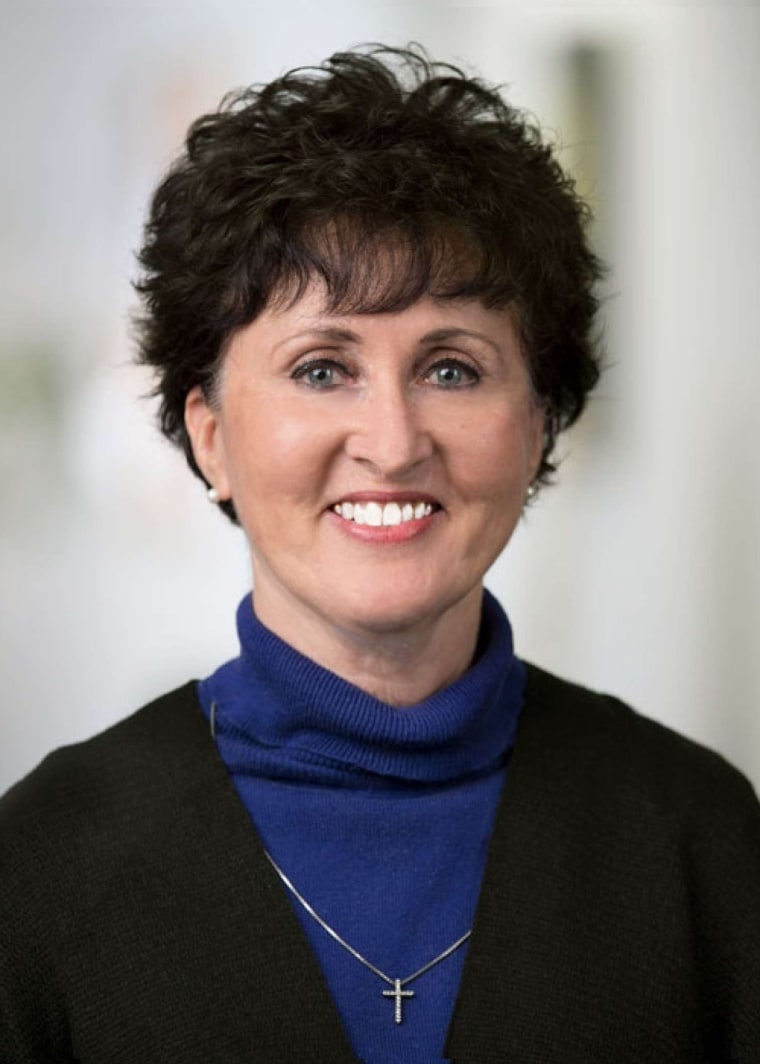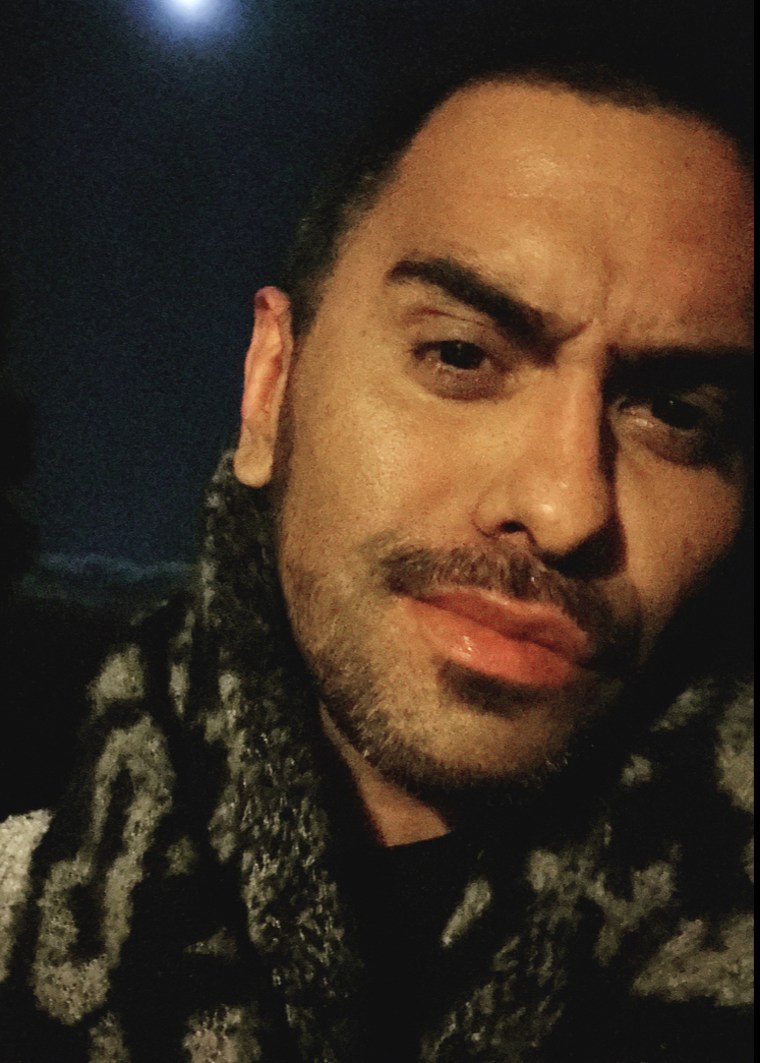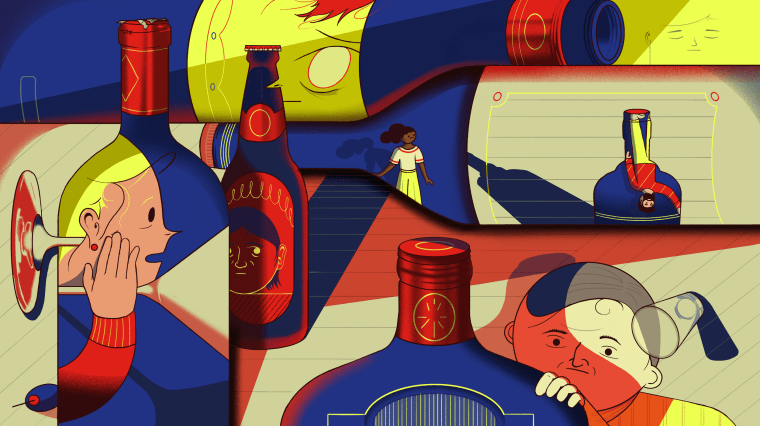Social-distancing measures and lockdowns have disproportionately increased alcohol use in the LGBTQ community, studies find.
Abigail Mazzarella, 26, often went to gay bars in Baltimore before Covid-19 stay-at-home measures were introduced.
“I don't live anywhere near my family, so I did depend on that community and friendships to get by and have a type of family here,” she said.
When bars in the state closed, this physical community disappeared as Mazzarella needed its support the most. But the liquor store across her street remained open. Around the same time Covid-19 infection rates were increasing early last March, Mazzarella’s mother unexpectedly died, and exactly one week later she lost her job because of the impact of pandemic restrictions.

“I started drinking pretty much immediately after all that happened, and didn't really stop for months,” she told NBC News. “I wasn't drinking socially; I was just doing it by myself in my house and spending a ridiculous amount of money on it for no reason other than just to get drunk, go to sleep and do it again the next day. I wasn’t functioning for a good half of 2020.”
Mazzarella has not had a drink in more than four months, but her experience with alcohol during the pandemic is far from isolated. Several recent studies investigating how both social-distancing and lockdowns affected LGBTQ people found alcohol use sharply increased.
One study discovered around one-third of men who have sex with men (MSM) reported their substance use or binge-drinking had increased during the Covid-19 lockdown, with another survey of LGBTQ university students in the U.S. by the University of Maryland Prevention Research Center revealing 32 percent were drinking more since the outbreak.
Drinking increased among the wider population during the pandemic, too, but at a lower rate compared to the LGBTQ community. Research published in September found that the frequency of alcohol consumption in the general population since the pandemic started grew by 14 percent above pre-pandemic levels. The Centers for Disease Control and Prevention also reported that 13 percent of U.S. adults said they had started or increased substance use, defined as use of “alcohol, legal or illegal drugs, or prescription drugs that are taken in a way not recommended by your doctor,” to cope with pandemic-related stress or emotions, in late June last year.
At-risk groups
Boredom, isolation and loneliness have been experienced by many Americans amid the pandemic. LGBTQ people, however, also face additional challenges, including increased stress from social prejudice and discriminatory laws, as well as family rejection due to their sexuality or gender identity, which can play a role in using damaging substance-based coping mechanisms.
Some parts of the LGBTQ community have seen particularly sharp rises in drinking over the past 11 months. According to research from John Salerno, who co-wrote the University of Maryland Prevention Research Center study of LGBTQ university students, 46 percent of transgender female students and 35 percent of queer-identifying students reported increased alcohol use since the start of the Covid-19 crisis.
“We found that those that reported an increase in alcohol use were more likely to suffer from greater psychological distress compared to those that did not report an increase in alcohol use,” Salerno, a Ph.D. candidate in behavioral and community health at the University of Maryland, said.
The breaking of social bonds among young LGBTQ adults who are exploring their identity can be especially traumatic. A study published in the Emerging Adulthood journal found that after social-distancing guidelines went into effect, LGBTQ people aged 18-29 had “lower levels of hope for the future, higher levels of alcohol use, a lower sense of connection to and pride regarding the LGBTQ community.”
Some LGBTQ students who moved back home as the pandemic spread had to isolate with families who don’t accept their sexuality or gender identity, according to Barrett Scroggs, an assistant professor of human development and family studies at Pennsylvania State University Mont Alto and co-author of the Emerging Adulthood report.
“These emerging adults are folks who might be leaving their college dorm where they're very comfortable, open and out. Then they return home to a house where they have to go back in the closet or maybe have to be with somebody who is homophobic, biphobic or transphobic,” Scroggs said.
Even before the pandemic, studies found that LGBTQ people, particularly women, are disproportionately likely to develop alcohol dependence and addiction, due in part to dealing with additional stressors.

Dianna Sandoval, chief clinical officer of AspenRidge Recovery, a network of rehab centers that offers LGBTQ-specific addiction treatment, explains that LGBTQ people are at a greater risk of being victims of violence and harassment, which can lead to more frequent cycles of distress and depression resulting in addictive behaviors.
“We’re already seeing higher levels of mental health challenges in the LGBT community being compounded with isolation,” Sandoval said. “Because it’s so difficult for folks to connect even to the small communities they’ve built for themselves, due to social distancing, there's an even greater distance between people in the LGBT community. Some people just don't feel that same sense of connection over Zoom.”
‘Perfect storm’
Christian Cerna-Parker, CEO of the New York-based nonprofit Gay and Sober, said he has seen the age of people reaching out to his organization dropping since the pandemic hit.
“I've seen people as young as 19 come in recently. Normally, people who reach out for help are in their 40s or 50s,” he said.
He added that the number of people seeking help from his organization with their substance misuse and addiction issues has rapidly shot up, too.
“From March until now, we’ve had a 40 percent increase in people wanting our services,” Cerna-Parker said.
He said for many people the combination of job losses, not being to partake in typical everyday activities and social isolation was “a perfect storm for an increase of alcohol and drugs.”
“Before they knew it, some of them found they were predisposed to addiction and things got out of hand,” Cerna-Parker said. “There's only so much that people can take. If they think: ‘I don't have a job, I don't have income, and the government is not sending me unemployment,’ there is lack of hope. That's a really dangerous place to be because the only thing they need to self-medicate is alcohol.”

Manny Minnie, 36, has experienced first-hand how the isolation and lack of social contact caused by Covid-19 restrictions can contribute to problematic drinking behavior.
“My thing with alcohol is that I drink a lot more when I'm bored,” Minnie, who lives in Los Angeles, said.
He had recently been diagnosed with AIDS and low immunity levels made it essential for him to enter quarantine. Minnie usually drank only on the weekends, but once lockdown was introduced, he said his drinking spiraled out of control.
“I was drinking every day. I’d start with a box of wine, then have a regular sized bottle of vodka and open a 12-pack of beer,” he said. “When I would wake up, I'd have maybe three beers left. It was a 24-hour thing.”
A check-up visit to his doctor was the catalyst for Minnie to stop drinking.
“Before I even thought about quitting drinking, I was drinking a lot. Then my doctor said: ‘I don't know what you're doing to your body. Your immunity is getting lower and lower; you have to stop doing whatever you're doing.’”
Anxiety, stress and physical withdrawal symptoms — mainly shaking and sweating — made the journey to sobriety a challenge, but Minnie said through painting, he found a way to channel his energy into a positive output, rather than turning to alcohol.
Now, Minnie is using his experience with alcoholism to help newcomers to 1,000 Hours Dry LGBTQIA, an Instagram community for queer people who are on a journey to sobriety or are “sober curious.”
"When I was drinking, it was like my energy source was this broken Bic lighter that would just have a spark,” Minnie said. “When I stopped drinking, the light just grew and grew.”
